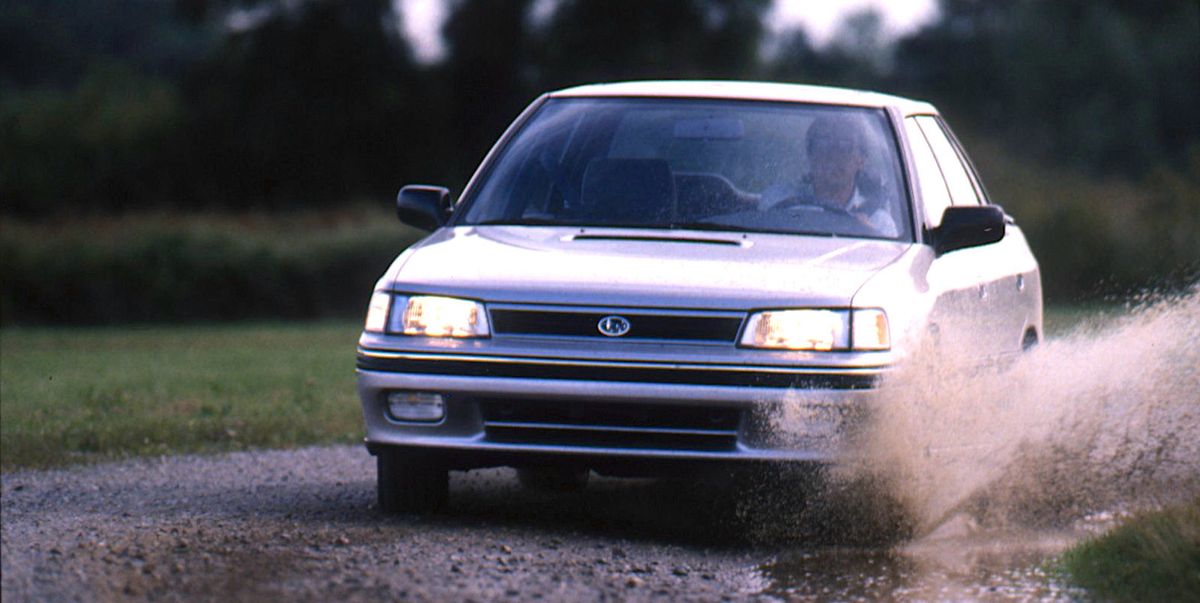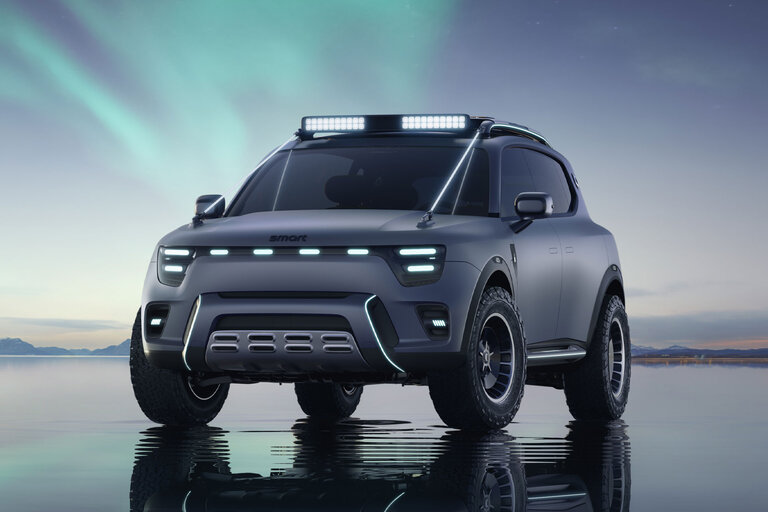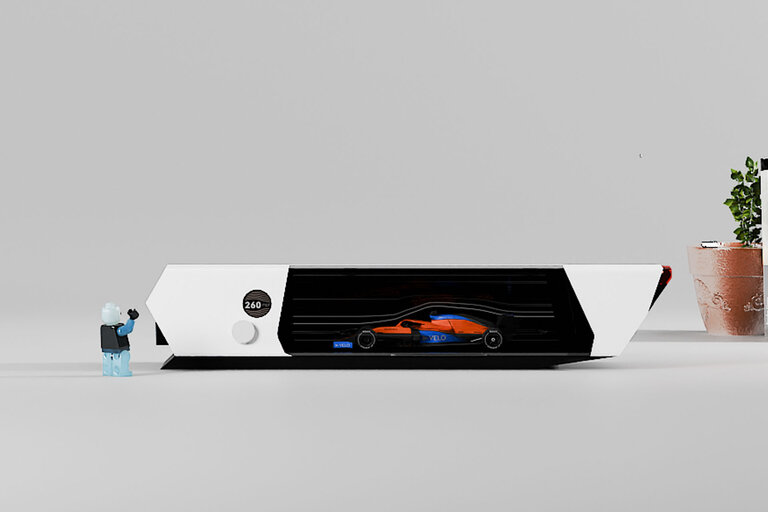
From the February 1991 issue of Car and Driver.
When Subaru announced it was going to bolt a turbocharger onto its best sedan, we happily anticipated the arrival of a Legacy From Hell. Imagine: 217 horsepower, 0 to 60 in 6.9 seconds, four-wheel drive. Why, John Buffum could nose this car out of the showroom Friday night and return on Monday morning with a massive SCCA PRO Rally trophy wedged into the back seat.
“No, no, not that car,” said Subaru’s Fred Heiler when we asked about this Legacy Sport Sedan’s stateside arrival. “This is a tamer version, a more mainstream car for the U.S.”
Uh-oh. You hear the word “mainstream” and you just know it’s going to include “Baby on Board” signs and a free tape of John Denver’s greatest hits.
Here’s the bad news: We won’t see the 217-horse four-cam because (1) it’s expensive to build, (2) it was intended only as a rally homologation exercise, and (3) it doesn’t jibe with Subaru’s image in America, which, as it happens, resembles nothing so much as a medley of John Denver’s greatest hits.
What we get instead is a Legacy Sport Sedan with a diminutive water-cooled IHI turbocharger that raises the SOHC 2.2-liter boxer’s output from 130 to 160 hp. Rocket shoppers will be disappointed, although the force-fed engine’s more significant statistic is the extra 44 pound-feet of torque payload arrives 1600 rpm sooner than it did before.
All of which is more important than it sounds. This turbocharged engine feels as smooth as a normally aspirated one, with the juice delivered from 2000 to 5500 rpm in a fat, seamless flow. That was Subaru’s intention. The turbo’s inlet is tiny, and both the angle and the curvature of its turbine blades are designed for rapid spool-up. Throttle response is very good, and there is no turbo lag. In fact, there’s no boost gauge in the cockpit. If it weren’t for the chrome “Turbo” badge on the Legacy’s rump and the subtle air intake near the base of the windshield (a scoop that does indeed work, force-feeding air directly atop the turbo snail in the interest of cooler operation), a lot of drivers would not know that this growly, whiskey-throated boxer was breathing artificially hard.
Under the whip, the Legacy Sport Sedan accelerates smartly, but the 160-hp engine is not entirely responsible. Some of the credit goes to sage engineering. This car weighs 3140 pounds, good for a five-passenger sedan with full-time four-wheel drive. It sprints to 60 mph in just 7.9 seconds and clears the quarter-mile in 16.1 seconds, which makes it a halfsecond quicker than the equally powerful Nissan Maxima SE.
We’re not talking about gobs of power here, and it’s tough to keep your right Florsheim out of the 8.7 psi of available boost. The penalty is a 19-mpg observed-fuel-economy figure—and the Sport Sedan insists on drinking premium unleaded.
We took the wheel for an eight-hour drive with Masaru Katsurada, the car’s chief engineer. Katsurada wanted to provide higher steering effort, as well as more aggressiveness from the spring rates, the anti-roll bars, the bushings, and the tires. But the final tuning, he groaned, would require a process he hates: a herd of engineers, product planners, and general hangers-on all bickering and nit-picking and fussing with the settings until, he said, ”I’d have a suspension with the personality of a committee, which is no personality.”
Katsurada’s solution: “I pointed at one of my engineers, a rally driver named Eiji Tatsumi, and I said to him: ‘Tatsumi, you select settings. You drive alone. You change suspension until you are happy. No one else. Then drive Legacy to me. That is the suspension we build.'” And that, he said, is what happened.
The engineer’s rally roots apparently were not deeply buried. He retained the Legacy’s long wheel travel and its relatively supple ride. At warp speed, the car still steps over railroad crossings and B-road yumps with grace and composure. But when the struts and springs approach the limit of their strokes, they are now 70-percent stiffer than those on non-turbo Legacys.
In day-to-day driving, the ride is nearly as compliant as the standard sedan’s (which makes you ask, “Why don’t all Legacys have these springs?”), and you feel the added stiffness only in the struts’ last inch of travel. The system clearly works: witness our Sport Sedan’s 0.80-g skidpad performance.
The unique tuning extends to the steering’s variable assist, which bleeds off far more quickly than the standard Legacy’s. This is a worthwhile improvement, although we’d still prefer more on-center feel above 45 mph.
Katsurada’s engineer mated six-inch-wide alloy wheels to Bridgestone RE88s. For no extra money, you can specify all-season RE92s if you live in a really filthy climate. But don’t do it unless you have to. Connected to four-wheel drive, the stickier RE88s offer generous grip and fine straight-line tracking, even during a near-blinding downpour on the greasy roads of the Green Mountains in Vermont. Moreover, we are loath to tamper with any tire-suspension combination that can stop from 70 mph in 173 feet, matching the stopping distance of a BMW 535i.
Subaru’s full-time all-wheel drive is a well-sorted system that is both reliable and virtually transparent in operation, and it accounts for less than a 200-pound penalty. In the Sport Sedan, the slick five-speed manual is mated to a mechanical center differential with a 50/50 front/rear torque split. Viscous clutches provide limited slip for the rear and center differentials. To cope with the additional torque, the Sport Sedan has a new hydraulic clutch with a pull-type release bearing. For some reason, this has made the clutch pedal stiff, and there is now more takeup vagueness than we appreciate.
Tearing along our favorite rollercoaster roads, the Sport Sedan rarely runs out of stick, but neither does it encourage you to toss it into turns. Hustle the car in rally-driver fashion and it simply plows resolutely, elongating the radius of its turn with the monotonous predictability of a Johnny Carson monologue. You can alter this trait in only one way: lift off the throttle and the front tires will bite instantly, returning to the business of steering and—presto!—you’re back on course. Product-liability lawyers will hate this car.
Buyers drawn to the Legacy Sport Sedan won’t need to spend much time jawing with salesmen—not a single option is needed. In addition to the standard four-wheel drive and Bosch ABS, the deal includes air conditioning, power windows, central locking, cruise control, a moonroof (which rattled like an annoyed diamondback in our test car), a sonically spectacular Clarion-built 80-watt stereo with four speakers, and special front seats with new (and nicely shaped) squabs and backrests.
The Legacy’s cabin is still awash in lifeless plastic surfaces whose tacky grain makes a mess of the doorsills, most of the dash, the headliner, the A-pillars, the sun visors, even the steering-wheel hub. Subaru’s leather-laden Legacy LSi would be just the ticket, but no turbocharged engine is offered in that model.
Bottom-line time: the Sport Sedan is carefully engineered, capable, and fast in its class. But it is also a car that drives like it looks—largely benign and bland, somehow failing to excite.
This $19,350 turbocharged Subaru would draw a lot more attention if it were priced to compete with $16,000 Honda Accords and Mitsubishi Galants. Instead, it finds itself within $650 of a nasty brawl with true luminaries in the hot $20,000 sports-sedan niche. It is, for example, neither as fast nor as firmly planted as the Ford Taurus SHO. It puts out the same 160 horsepower and rides as capably as the jewel-like Nissan Maxima SE, but it is not as luxurious, as finely finished, nor as satisfying to drive.
This revised Legacy’s principal allure—and the hook on which the marketing mavens seem dangerously willing to hang most of Subaru’s recently dwindling fortune—is maximum traction: four-wheel drive and ABS. That may carry the car to glory in Vermont, and it may give John Denver a rocky-mountain high. But it makes the car a quirky choice—a kind of Subaru hallmark, come to think of it—in most other areas. The Legacy Sport Sedan is a car we respect more than we desire.
Specifications
Specifications
1991 Subaru Legacy Sport Sedan
Vehicle Type: front-engine, 4-wheel-drive, 5-passenger, 4-door sedan
PRICE
Base/As Tested: $19,294/$19,357
Options: floor mats, $63
ENGINE
turbocharged SOHC flat-4, aluminum block and heads, port fuel injection
Displacement: 135 in3, 2212 cm3
Power: 160 hp @ 5600 rpm
Torque: 181 lb-ft @ 2800 rpm
TRANSMISSION[S]5-speed manual
CHASSIS
Suspension, F/R: struts/multilink
Brakes, F/R: 10.9-in vented disc/10.5-in vented disc
Tires: Bridgestone Potenza RE88
195/60HR-15
DIMENSIONS
Wheelbase: 101.6 in
Length: 177.6 in
Width: 66.5 in
Height: 53.5 in
Passenger Volume, F/R: 47/36 ft3
Trunk Volume: 14 ft3
Curb Weight: 3140 lb
C/D TEST RESULTS
60 mph: 7.9 sec
1/4-Mile: 16.1 sec @ 84 mph
100 mph: 24.2 sec
120 mph: 57.3 sec
Top Gear, 30–50 mph: 11.4 sec
Top Gear, 50–70 mph: 10.1 sec
Top Speed: 129 mph
Braking, 70–0 mph: 173 ft
Roadholding, 300-ft Skidpad: 0.80 g
C/D FUEL ECONOMY
Observed: 19 mpg
EPA FUEL ECONOMY
City/Highway: 19/25 mpg
#Subaru #Legacy #Sport #Sedan #Sport
Source link





